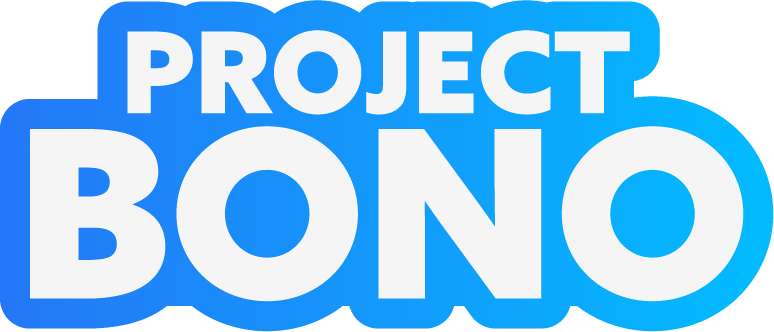
Building Bridges: How Collaboration between Schools, Courts, and Community Organizations Can Improve Outcomes for At-Risk Youth
Discover the power of collaboration between schools, courts, and community organizations to create lasting change for at-risk youth. In this insightful article, we explore how innovative solutions like Project Bono's court-ordered courses can bridge gaps in support systems, offering a comprehensive approach to enriching communities across the United States and Canada. Learn about the importance of collaboration, the role of Project Bono, and the potential of collaborative partnerships in improving outcomes for at-risk youth.
Table of Contents
The Importance of Collaboration
The Role of Project Bono
The Potential of Collaborative Partnerships
Conclusion
In today's fast-paced and demanding world, courts stakeholders and other community administrators face significant challenges such as time restrictions, deadlines, financial constraints, and other factors that can make it difficult for them to singlehandedly address the diverse needs of at-risk youth. To create lasting change and promote positive outcomes, schools, courts, and community organizations must work together to form a comprehensive support system for these young individuals. In this article, we will explore the power of collaboration in improving outcomes for at-risk youth and discuss how innovative solutions, such as Project Bono's court-ordered programs, can help bridge the gaps in this support system and enrich communities across the United States and Canada.
The Importance of Collaboration
Today’s youth face a myriad of challenges, from academic struggles and truancy to mental health issues and involvement in the juvenile justice system. Addressing these challenges requires a multi-faceted approach that draws on the expertise and resources of various support systems.
By fostering collaboration between schools, courts, and community organizations, we can create a holistic support network that addresses the root causes of at-risk behavior and provides the necessary resources for these young individuals to thrive. This collaborative approach not only leads to better outcomes for at-risk youth, but also benefits the wider community by reducing crime and recidivism, improving public safety, and promoting social cohesion.
The Role of Project Bono
Project Bono is an innovative education platform that offers court-ordered courses for individuals seeking to fulfill legal requirements related to DUIs, drug offenses, truancy, and other legal infractions. By providing accessible, engaging, and evidence-based courses, Project Bono helps bridge the gap between the legal system and other support structures, such as schools and community organizations.
One of the key advantages of Project Bono's courses is flexibility. The courses can be completed on a variety of devices, including computers, smartphones, and tablets, allowing participants to access the content at their own pace and in their preferred learning environment. Our self-paced model makes it easier for students to fulfill their mandatory education requirements without interfering with other responsibilities like school, work, or family support obligations.
Project Bono's courses are also designed to be engaging and interactive, ensuring that participants retain the information and can apply it to their lives. This is particularly important for at-risk youth, who may struggle with traditional educational settings.
The Potential of Collaborative Partnerships
When schools, courts, and community organizations partner with platforms like Project Bono to streamline the process of assigning education requirements, they can create a more comprehensive and effective support system for at-risk youth. For example, a school might require a student with truancy issues to Project Bono's Truancy Prevention program during several lunch periods, which provides targeted education and support to help the student get back on track without disrupting schoolwork or responsibilities outside of school.
One of the key aspects of Project Bono's programs is our dedication to supporting and enriching the community. We recognize that the long-term success of at-risk individuals relies heavily on collaboration with local entities such as schools, legal systems, and community-based initiatives. To encourage this collaboration, we've introduced a unique value proposition: when community organizations refer individuals to any Project Bono program, we give back 25% of the enrollment proceeds to the referring organization.
This reinvestment empowers organizations to provide essential resources and services, fostering an environment where they can continue to make a significant impact on the lives of those they serve. By partnering with Project Bono, organizations not only provide valuable educational courses to offenders but also contribute to the overall improvement of their community.
This reinvestment empowers organizations to provide essential resources and services, fostering an environment where they can continue to make a significant impact on the lives of those they serve. By partnering with Project Bono, organizations not only provide valuable educational courses to offenders but also contribute to the overall improvement of their community.
Conclusion
Building bridges between schools, courts, and community organizations is essential for improving outcomes for at-risk youth. By fostering collaboration and leveraging innovative solutions like Project Bono's court-ordered courses, we can create a comprehensive support network that empowers these young individuals to succeed and contribute positively to their communities. To learn more about how Project Bono can help your organization support at-risk youth, visit our website or get in touch with us today.
Page last updated: March 16th, 2023
OUR COURSES
Drag to resize

Project Bono provides the most affordable up-to-date online classes that fulfill court and employer mandates while contributing 25% of proceeds towards charitable causes.
SOCIAL LINKS
RESOURCES
-
About Us
-
Print a Referral
-
Example Certificate
-
Where We're Accepted
Drag to resize
SUPPORT
Drag to resize


Copyright © 2024 Project Bono. All Rights Reserved
Money-Back Guarantee
All of our courses are backed by a 30-day money-back guarantee. If your certificate of completion is not accepted, contact us with proof of decline.
We recommend you confirm that your assigner will accept our certificates before you enroll in any of our courses.
Note: Cryptocurrency payments do not qualify at this time.
We recommend you confirm that your assigner will accept our certificates before you enroll in any of our courses.
Note: Cryptocurrency payments do not qualify at this time.
Drugs & Alcohol
MIP
Anger
Truancy
Cannabis
Bullying
Theft
Nicotine
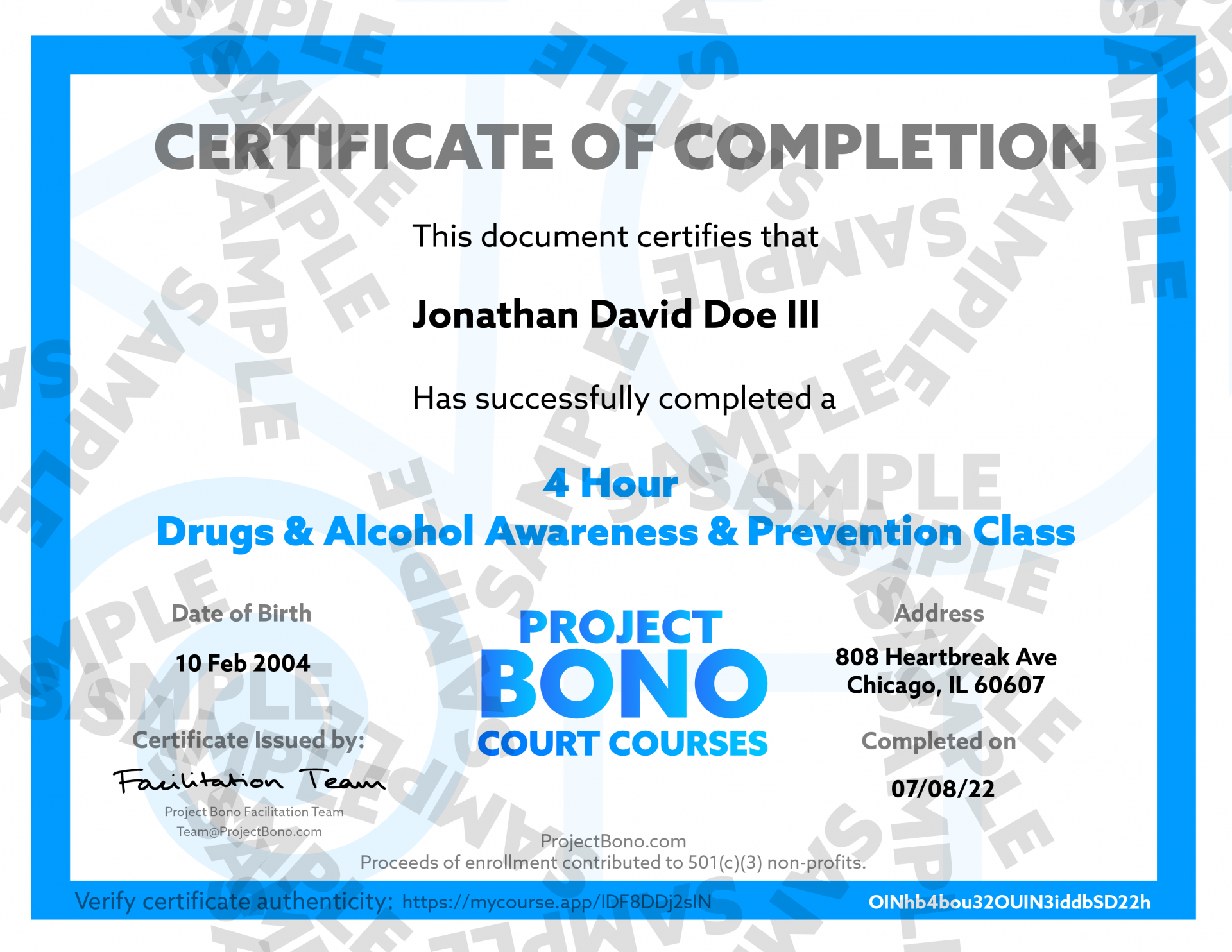
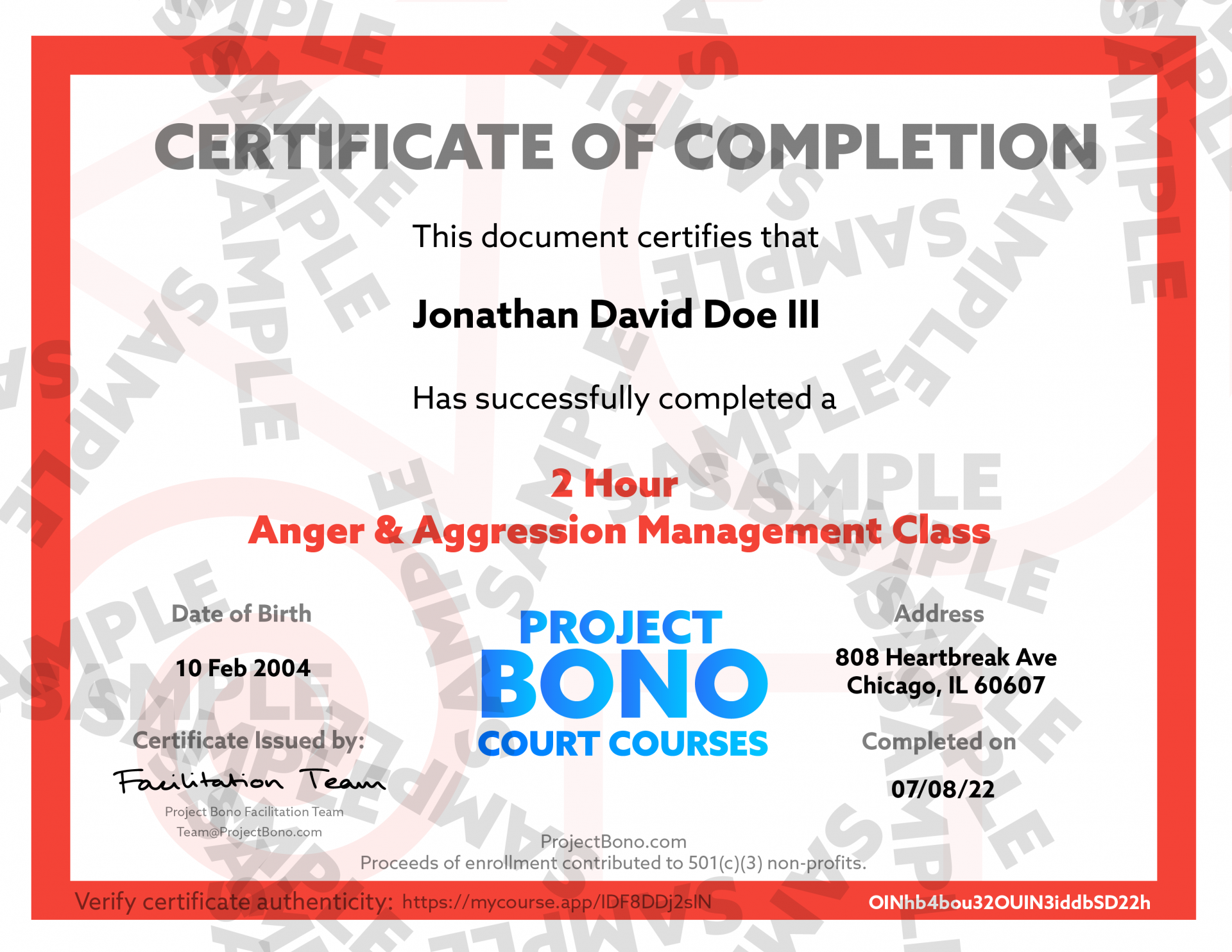
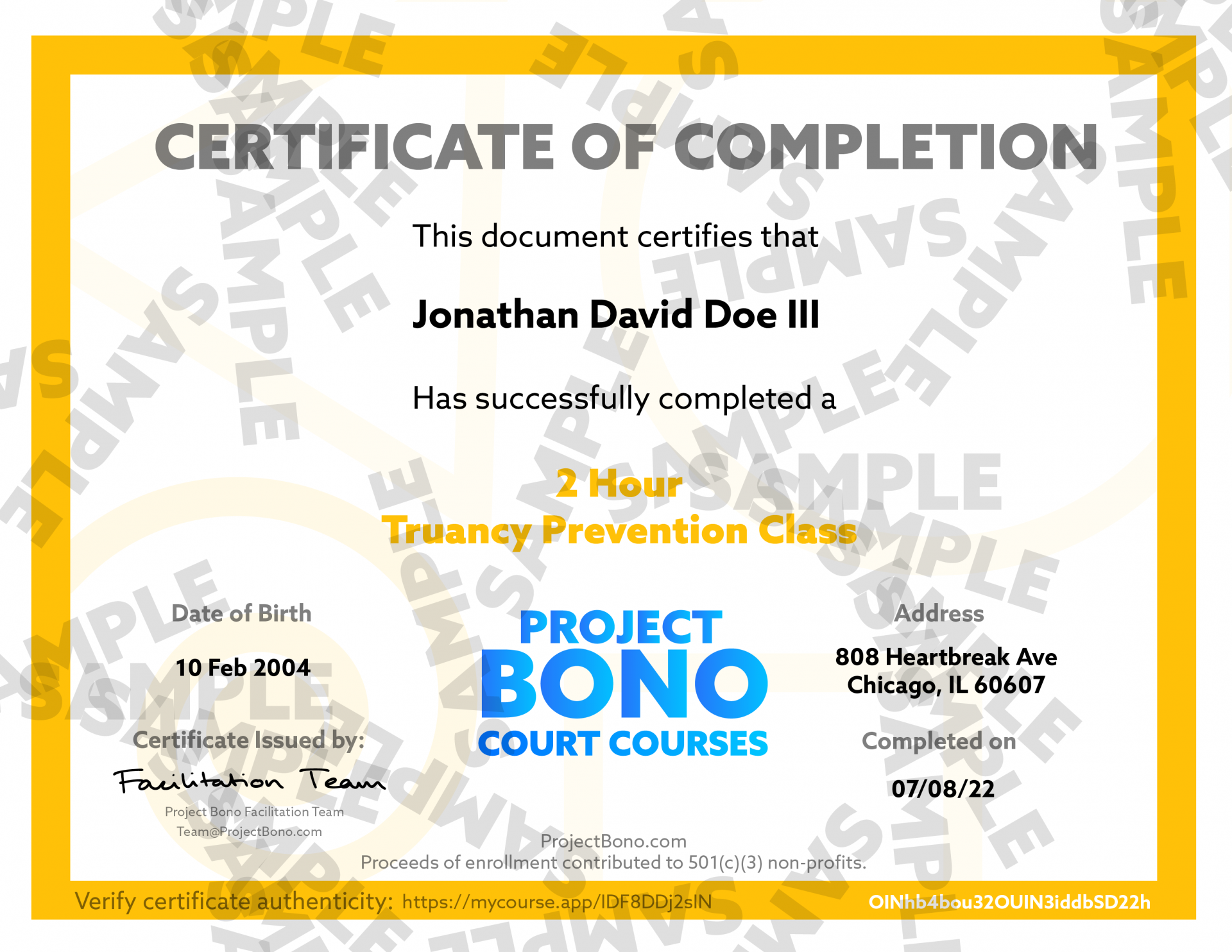
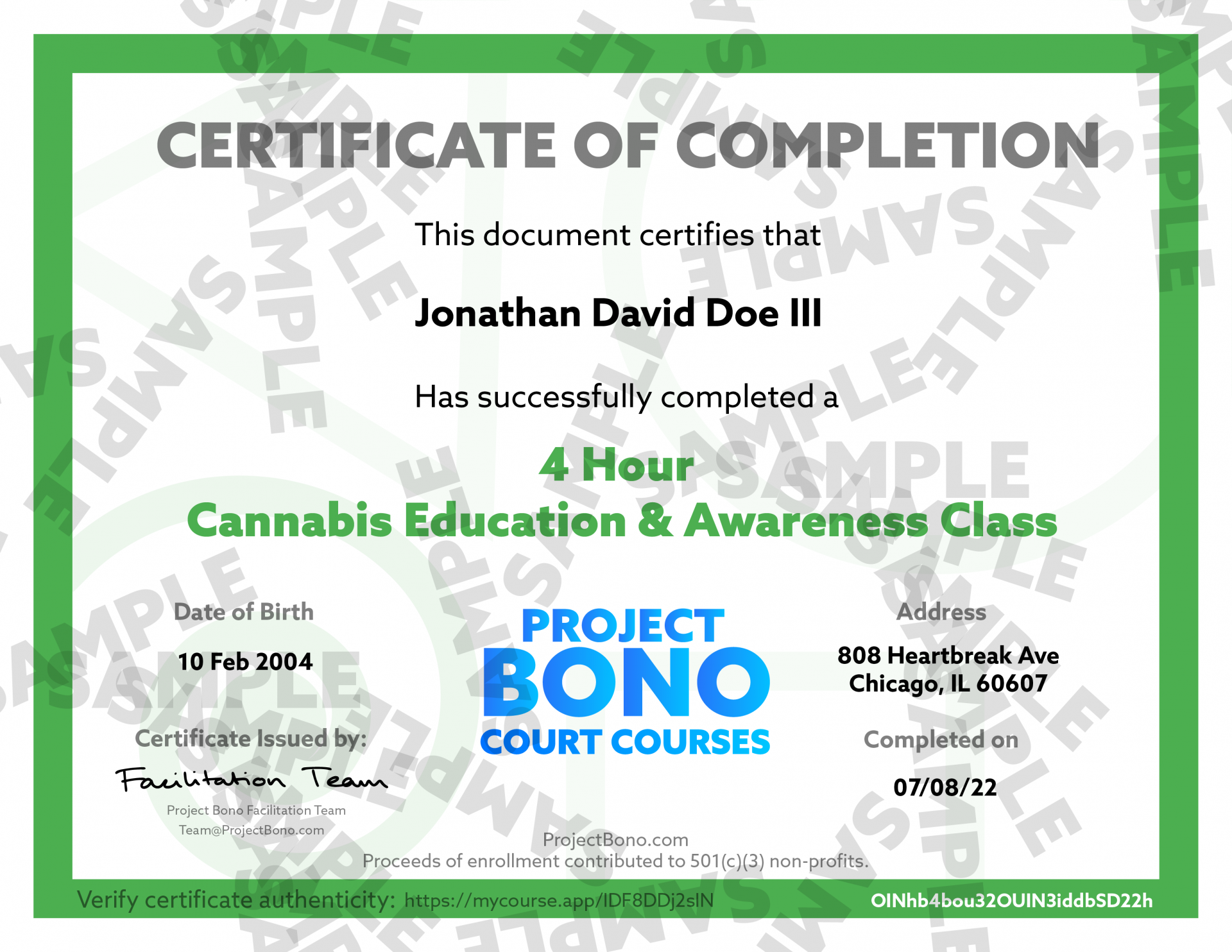
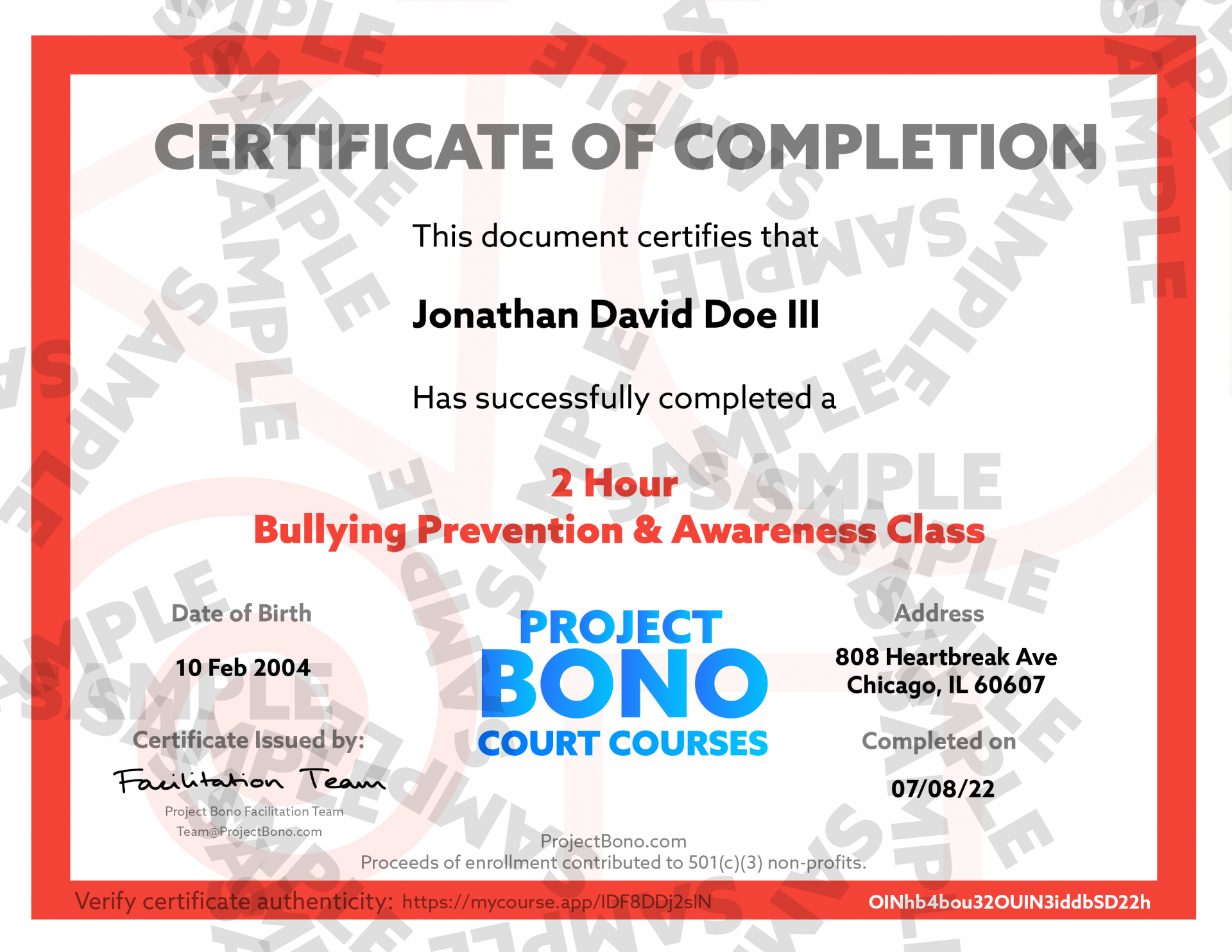
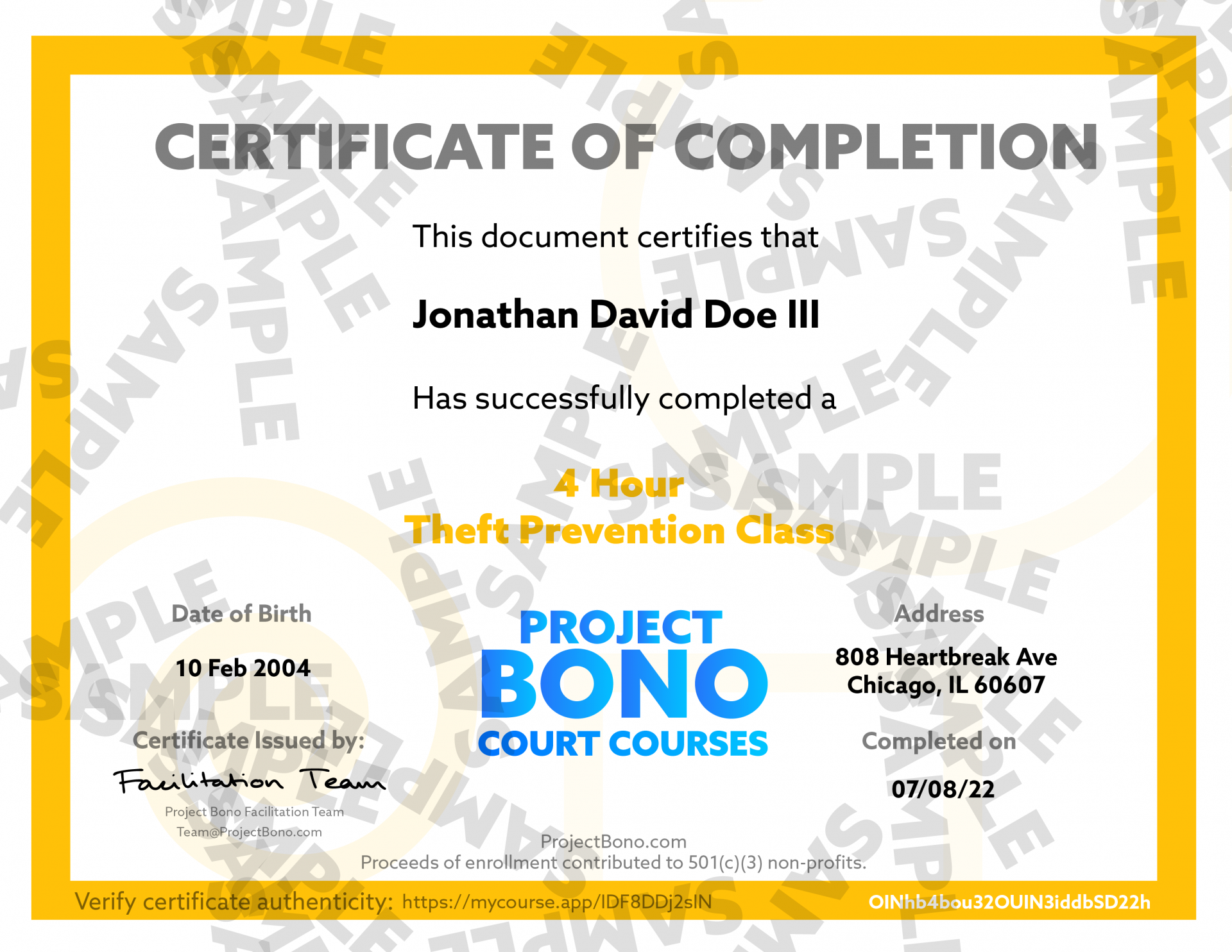
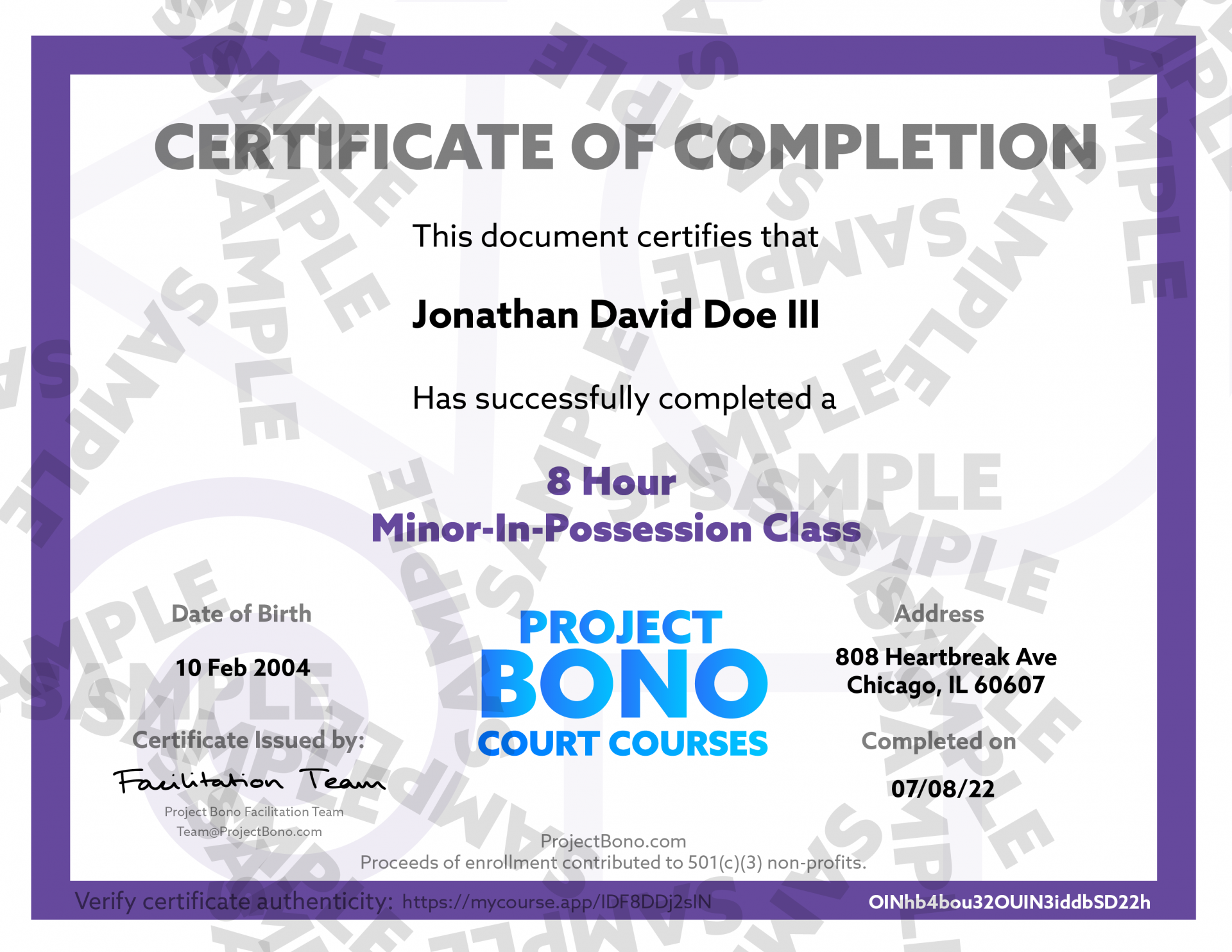
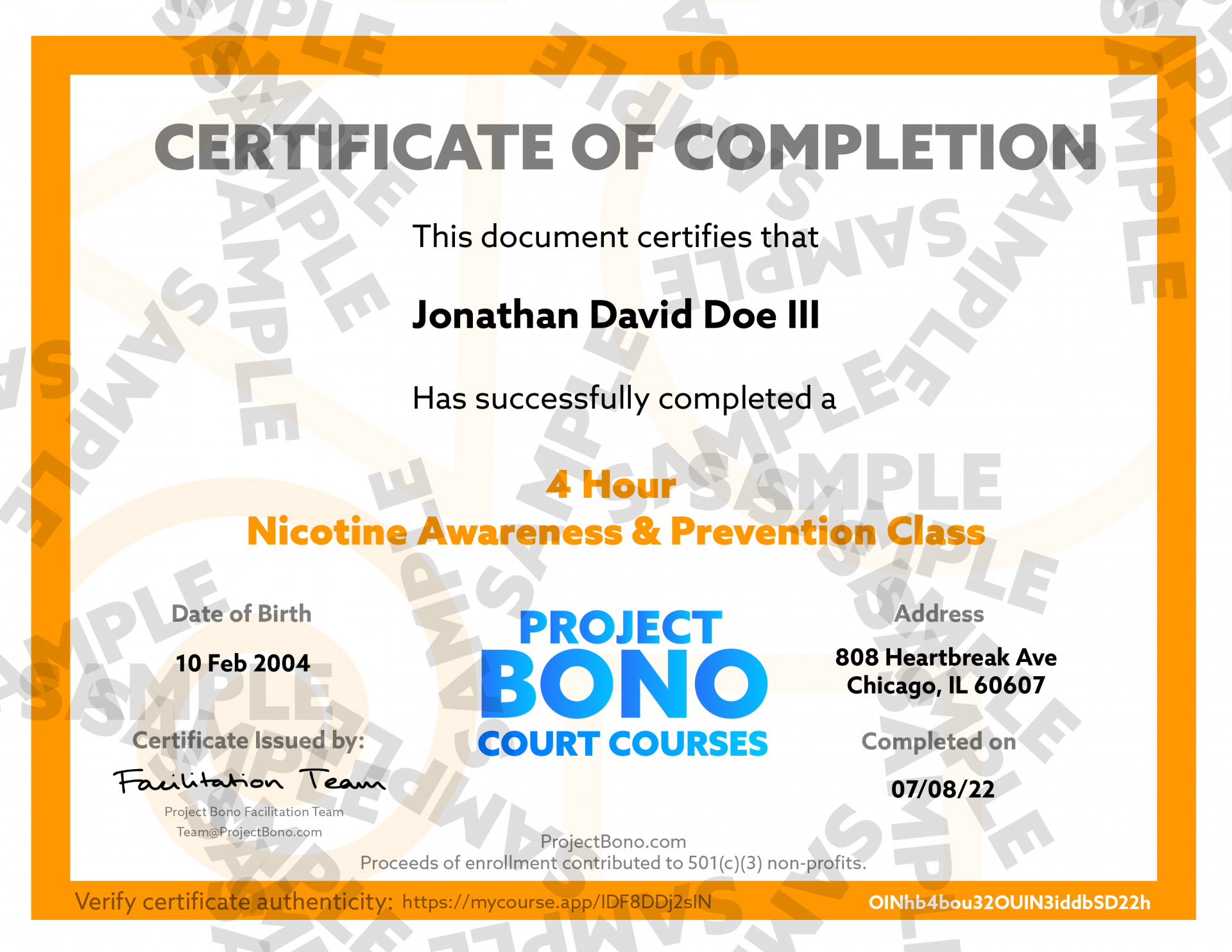
Course updates
Course contents and formatting are subject to improvements.
We are constantly monitoring current scientific and legislative data to provide you with the most accurate information within our courses. When you purchase any of our courses you are entitled to all future versions of the course.
We are constantly monitoring current scientific and legislative data to provide you with the most accurate information within our courses. When you purchase any of our courses you are entitled to all future versions of the course.
PrintableHandouts
Download and print PDF handouts to easily direct students to the correct course and start assigning!
How does Project Bono work?
Project Bono offers correctional education programs that aim to educate first-time and repeat offenders about the risks associated with substance abuse and harmful behaviors.
As you progress through our courses, you'll have access to various forms of media, including videos, to help you understand the material.
Once you've completed the course and met the time requirement, you'll receive a certificate of completion that you can share with your court, school, or employer.
As you progress through our courses, you'll have access to various forms of media, including videos, to help you understand the material.
Once you've completed the course and met the time requirement, you'll receive a certificate of completion that you can share with your court, school, or employer.
One thing that makes Project Bono stand out is that we donate 25% of enrollment proceeds back to the communities that assign our programs.
This means that by assigning our programs, not only are individuals learning valuable life skills and building awareness, but they are also enriching the communities that assign our programs.
This means that by assigning our programs, not only are individuals learning valuable life skills and building awareness, but they are also enriching the communities that assign our programs.
What Programs are offered?
We cover a wide range of topics including Drugs & Alcohol Awareness, Cannabis Education, Minor in Possession (MIP), Nicotine Prevention, Bullying Prevention, Anger Management, Theft Prevention, Truancy Prevention, and more.
We continuously update our programs to reflect current research and trends in substance abuse and other harmful behaviors.
Forgot your Password?
If you forgot your password, you can reset it by clicking on the "Forgot your password?" link on the login page.
If you signed up with an existing social account and the "Forgot your password?" solution doesn't work, you may need to change your password on the existing social account.
If you signed up with an existing social account and the "Forgot your password?" solution doesn't work, you may need to change your password on the existing social account.
Can I take a course on my phone?
Yes!
All of our courses are accessible across any device with a web browser.
All of our courses are accessible across any device with a web browser.
Can I take a course on my phone?
Project Bono is accessible to anyone with a web browser (such as Google Chrome, Safari, Microsoft Edge, etc.), and a stable internet connection. Whether you choose to participate from a desktop computer, laptop, tablet, or smartphone, you should be able to access our programs with ease.
Our website is designed to adjust to your device's screen size and resolution, making it easy to start a course on one device and pick up where you left off on another. If you have any questions about the technology required to participate in our programs, our support team is always here to help.
Our website is designed to adjust to your device's screen size and resolution, making it easy to start a course on one device and pick up where you left off on another. If you have any questions about the technology required to participate in our programs, our support team is always here to help.
What if my certificate is not accepted?
If your certificate of completion is not accepted by a member of the court, counselor, employer, administrator, or any other occupational, educational, or legal assigner, please contact us.
Our certificates come backed with a 30-day acceptance guarantee. If your certificate is not accepted for any reason, please provide us with documented proof of rejection, such as an email or written statement from the assigner.
We always recommend contacting your issuing party before purchasing any of our courses to confirm they will accept your certificate. Please note that refunds in these cases are only granted within the 30-day guarantee period.
How do I request a refund?
If you need to request a refund for any reason, including if your certificate of completion is not accepted by your assignor, you can do so by sending us an email at team@projectbono.com.
To enact our acceptance guarantee, please include in your email a written proof of decline from the assignor that includes a way of reaching them. If the request is within 30 days of your purchase and meets the criteria of our acceptance guarantee, we will process your refund promptly.
Please note that refunds that don't qualify for the acceptance guarantee, such as those requested outside of the 30-day window or for reasons other than non-acceptance by your assignor, are reviewed and issued on a case-by-case basis.
If you have any questions or concerns about requesting a refund, please don't hesitate to contact our customer support team at team@projectbono.com.
Am I able to pause the course?
Yes, participants are able to pause the course and continue at any time, on any device. Our platform is designed to save your progress consistently while you participate in the course, so you can pick up right where you left off. Whether you need to take a break for a few hours or a few days, you can rest assured that your progress will be saved.
We want you to get the most out of our courses and achieve your goals, and that means being able to learn at your own pace and on your own schedule. So go ahead and take a break if you need to - we'll be here when you're ready to continue.
How long does it take to complete a course?
The time it takes to complete a course varies depending on the time requirement you choose. When you enroll in a course, the time requirement will be clearly stated on the course page, along with an estimated completion time based on that requirement.
If you're unsure about which time requirement to choose or have any other questions about course completion time, you should reach out to your assigning party.
What does the certificate look like?
Every certificate generated by Project Bono includes the following information: course title and time requirement, student's name, birth date, address, date of completion, and certificate verification link. This information is unique to each certificate and cannot be duplicated or edited.
We offer certificates in PDF format because it's the most efficient way to send documents over email, while also reducing paper, ink, energy, transportation, and overall costs required to mail a physical copy.
Remember, it's important to submit your certificate of completion to your assignor as soon as possible to avoid any complications. If you have any questions or issues, please contact our support team for assistance.
Hollup.
Who are You?
Acceptance Guarantee
Enhance your assurance with our 30-Day Acceptance Guarantee.
Whenever you enroll in a Project Bono program, you have the peace of mind knowing that our certificate is backed by our Acceptance Guarantee. If your certificate isn't embraced by the assigning entity, we've got you covered.
Simply provide us with a proof of decline, and we'll handle the rest.
Simply provide us with a proof of decline, and we'll handle the rest.
◊ Acceptance Guarantee: Offer is only valid for 30 days from the date of certificate issuance and is available to participants within the U.S. The guarantee is subject to validation of the proof of non-acceptance provided by the enrollee. For detailed information regarding our policy, see support.projectbono.com/acceptance-guarantee.